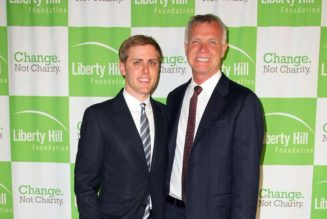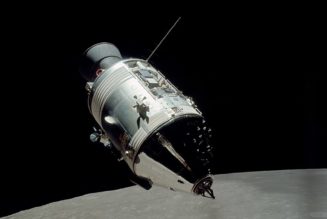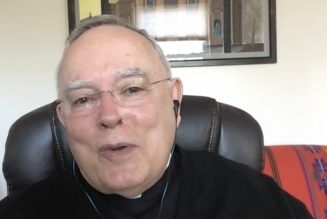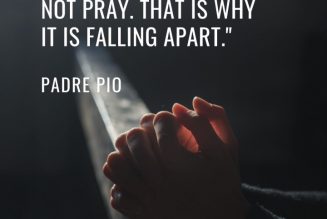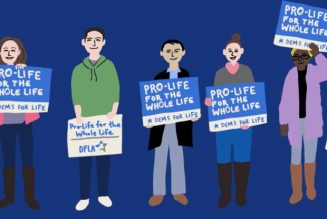
Father Ryan Connors prayed over a Covid-19 patient while he administered a Catholic sacrament, the anointing of the sick, at St. Elizabeth’s Medical Center.
For centuries, Catholic priests have anointed the dying with oil. The ritual has become extraordinarily difficult during the coronavirus pandemic. But in rare instances priests have still been able to offer last rites.
Beyond the glass lay a man, unconscious in the electric blue light, shrouded in tubes. His family was not allowed to visit. His body could not be touched.
Father Ryan Connors stood at the door watching, his Roman collar barely visible beneath his face shield.
Since the coronavirus pandemic began, he had gone to the bedsides of Covid-19 patients across the Boston area to perform one of the oldest religious rituals for the dying: the Roman Catholic practice commonly called last rites.
For centuries, priests have physically anointed the dying with oil to heal body and soul, if not in this life, in the next. Many Catholics have spent their entire lives trusting that in their most difficult hours a priest, and through him God, would come to their aid.
On this Tuesday morning, in the intensive care unit at St. Elizabeth’s Medical Center, west of the city, all that Father Connors knew about the patient was his name, and that his family had called for a priest.
He had a clear plastic bag with a cotton ball containing a few drops of holy oil. He carried a photocopy of pages from a liturgical book.
At 10:18 a.m., he slid open the door. He walked over to the bed, careful to avoid the tubes on the ground.
He stretched out his hand, and began to pray.

Father David Barnes after anointing a Covid-19 patient at Newton-Wellesley Hospital.
The coronavirus has led the United States to the valley of the shadow of death. In just three months, a microscopic particle has laid bare human mortality. The entire nation has worked to avoid death, shutting down cities, masking faces in the streets, and isolating the dying from their loved ones in their final hours. And yet, more than 100,000 people have died, and often, died alone.
Many rituals, a guide through life’s most sacred moments, have been impossible. Children said final goodbyes to dying parents through windows or on FaceTime, if they bid farewell at all. Only rarely have religious leaders been allowed into hospitals and nursing homes. Families attend funerals on Zoom.
The country is facing a deeply personal crisis of spirit, not only of health or economics. A virus has forced a reckoning with the most intimate questions we have, questions not only about how we live, but also about how we die. About what we can control, and what we cannot. About how to name human dignity, despair and hope. And especially about how to make meaning of our final hours on this earth.
“This major disaster is going to change our relationship to death; I’m not exactly sure how, but I am certain it will,” Shannon Lee Dawdy, professor of anthropology at the University of Chicago, said. “This is happening psychologically to us all.”
Long before the rise of the major religions of the modern world, humans have used rituals to process death. They have honored the sacredness of life by burying the dead. They have offered incantations or objects to prepare people for an afterlife.
This pandemic arrived in a country drifting away from many of its faith traditions. Christianity, the majority religion in America, has been slowly declining for decades. During the flu pandemic of 1918, many churches closed for services, but there was little question that a minister could visit the dying. A century ago, priests were “answering sick calls night and day,” one Catholic newspaper reported at the time. Now nurses and doctors, not spiritual leaders or families, are most likely to be death’s witnesses.
Not too many generations ago, the family of a person who died might wear black for months, stop all the clocks in the house, close the shutters, and put straw on the road to dull sounds, said Teresa Berger, professor of liturgical studies at Yale Divinity School.
“There was a vast ritual practice around death and dying that we today have constrained,” she said. “We don’t know how to accompany the dying ritually, we leave that to the hospital.”
Some rituals have remained. Jewish families wash the body after death and sit shiva. Many Muslims turn a dying loved one’s bed toward Mecca. And in Catholicism, there are last rites.
As coronavirus cases surged in Boston, Cardinal Sean P. O’Malley, the Roman Catholic archbishop, designated a task force of 21 priests to be trained to safely anoint Covid-19 patients. The city, heavily Catholic, is one of the few places in the country where some hospitals have allowed priests to enter during the pandemic.

”The most significant moment, the defining moment of our life is how we die,” Father Barnes said.

Father Barnes dons personal protective equipment at St. Elizabeth’s Medical Center before anointing a Covid-19 patient.

Diane Roberio received the anointing of the sick from Father Barnes at St. Elizabeth’s Medical Center.
Father Brian Conley, a Jesuit chaplain at Brigham and Women’s Hospital, has done about 100 anointings since the pandemic began, sometimes five a day as the cases peaked.
“The whole point of the sacrament is a reminder that we are not alone,” he said. “The church is present with this person, and God is present with this person.”
Last rites are actually three sacraments, or rituals that the church believes channel divine grace: a final confession and forgiveness of sin, an anointing of the sick, and eucharist, the remembrance of the body and blood of Christ.
The ancient practice goes back to a church that was born, quite literally, from a dying man. Biblical narratives recount Jesus laying hands on the sick, healing and forgiving them, and his disciples anointing the sick with oil. As he died on the cross, he forgave his enemies and committed his spirit into God’s hands.
At the time, a common Roman death ritual was to put a coin in the mouth of the deceased, to pay the fare for the journey across a river to the afterlife. The early church substituted bread for the coin, to give the deceased food for the journey into God’s presence. It was a final eucharist celebration, known in Latin as “viaticum,” or “provisions for the way.”
In medieval Europe, when plagues killed one in three people, the anointing of the dying became even more prominent. Life spans were short, and death was unpredictable and seen as divine punishment. It was an age of anxiety, the era of Dante’s “Inferno,” when many worried their souls would suffer in purgatory for their sins. Last rites absolved a dying person and assuaged fear over one’s eternal fate.

Ars moriendi, German, circa A.D. 1475
An entire genre of literature, ars moriendi (“the art of dying”), developed on how to die well. Handbooks that spread across Europe outlined final prayers for the dying and their families, and how to avoid temptation and fear in the final hours.
“It’s very hard for modern secular individuals to grasp the level of despair,” Ralph Keen, chair of Catholic studies and professor of history at University of Illinois at Chicago, said. “A just God punishing fearful humanity, there is nothing more frightening.”
“It was meant to be a sacrament of comfort,” he said.
After World War II, the Vatican expanded anointing to the sick as well as the dying. Priests began to anoint people who faced surgery or had a serious illness, like cancer.
The sacrament is a way to recognize the sacredness of every human life, explained the Rev. Michael Witczak, associate professor of liturgical studies and sacramental theology at the Catholic University of America. The sick, the sinners, and the dying all have values and rights, he said.

Father Barnes leaves the room of a Covid-19 patient at Newton-Wellesley Hospital.

Ms. Roberio in the intensive care unit at St. Elizabeth’s Medical Center.
The word “patient” comes from Latin, originally meaning “one who suffers.” But amid a frightening new disease like Covid-19, patients can be seen first as problems to be solved or statistics, he said.
“What bringing the sacrament to them does is remind us they are human beings with a past and present and hopefully some kind of future,” he said.

Father Connors in the parking lot of St. Elizabeth’s Medical Center.

Father Connors preparing his materials in the trunk of his car before entering the hospital.
The patient beyond the glass at St. Elizabeth’s was Dunia Barrios’s father. Just a few days earlier, she remembered, he was searching for a religious station on the radio as he waited for an ambulance to take him to the hospital, hoping to hear a prayer.
She wished she could just touch his hand, just give him a kiss. Ms. Barrios is not Catholic, but her father, a 59-year-old handyman who did tiling and roofs, attended Mass every Sunday. A friend told her about last rites, and she looked them up online. Two weeks after he was put on a ventilator, she called for a priest.
“I know people are unconscious,” she said. “But sometimes you wonder, from a religious aspect, how unconscious are they? Can they really hear you?”
“Science will tell you something, but there is more than science,” she said. “We just feel, if we were there, if we could touch him …”
Her voice trailed off.
The assurance of holy presence is a solace not only for the dying, but for loved ones left behind. Denying the sacrament can be devastating. In April, 95-year-old Elvira Arbusto died of Covid-19 in a care center in Connecticut. Her children could not get anyone to set up a video so they could speak to her, much less arrange for a priest.
“I know that she would have wanted that and it would have helped the family as well,” her daughter-in-law, Beth Cioffoletti, said. “It was a very disturbing few days, thinking of her left in a room to die.”
For some families, the anointing leaves open the hope of a miracle. Addis Dempsey, who goes by Skip, was unconscious and intubated at St. Elizabeth’s when a priest came to minister the sacrament in early May. Listening via speakerphone was Mr. Dempsey’s cousin, Father Bill Williams, who had offered the same prayers countless times during his 52 years as a parish priest.
The sacrament was a ritual of healing, he explained later, a reminder that no matter how things turn out, God is with you.

Father Connors praying over Skip Dempsey, a paramedic with Covid-19.

“Sacraments are like hugs from God, the moments when he embraces us,” Father Bill Williams said.
“It is not magic,” Father Williams said. “It is the faithful calling on God, and saying, ‘God, we need a hug right now.’ I’d say sacraments are like hugs from God, the moments when he embraces us. And nobody likes quick hugs.”
A few days later, Mr. Dempsey no longer needed a ventilator. Soon he was extubated, and able to talk for a few minutes on the phone to another cousin, Peggy Golden, as he began his recovery.
“There were a whole lot of things being poured into him, and God was one of them,” she said. “I have to believe that all of them played a part in the fact that I talked to him yesterday. Somebody is in control of this. If he chose to heal him here, that works fine for me.”

Father Connors, left, and Father Barnes on a weekly call with other priests who are anointing Covid-19 patients at Boston hospitals.
When Ms. Barrios asked for her father to be anointed, a hospital chaplain called Father Connors, who was in the middle of teaching a moral theology class online.
When the death counts began to rise in Boston, Father Connors moved into isolation with two other priests who are also part of the archdiocese’s Covid-19 teams. Before one of the priests leaves their home to anoint the sick, he puts a clean pair of shoes just inside the back door. When he gets back, he immediately does a load of laundry.

Father Barnes in the kitchen of the home where he, Father Connors and Father Thomas Macdonald lived in quarantine.

Father Barnes, left, Father Macdonald, center, and Father Connors, right, celebrate Mass in their attic.
Between calls, the three priests paused to reflect on their ministry. Father David Barnes had just anointed a dying patient at Newton-Wellesley Hospital.
“You often think, this person is going to be in heaven after they talk to me,” Father Barnes said. “That is always very sobering, but it is also very beautiful, that you can be there in that moment with someone.”
“The most significant moment, the defining moment of our life is how we die,” he said.
Now is an opportunity for all people to examine their own lives and to face hard questions, he explained: “What is important in life? What is the ultimate meaning of life? What is your ultimate hope?”

Father Macdonald in their home in Brighton.
Father Thomas Macdonald remembered how nurses would sometimes join in prayer with him as he anointed patients in intensive care.
“It’s easy to be secular, it is easy not to believe in God, when you think humanity basically has control over its own destiny and its affairs,” he said. “To live well requires preparing for death, recognizing that death is part of our human destiny. Without a belief in God, without a belief in a real purpose for our lives, I don’t know how that is done.”
And while the future of religion in America may be interesting to ponder, Father Connors said, he is focused on the job at hand: caring for people’s real spiritual needs.
“In 400 years, whatever happens in a pandemic, there will be priests to anoint God’s people,” he said. “Whatever happens.”

Father Connors wheeled a tablet into Dunia Barrios’s father’s room so she could remotely watch the ritual.
In the room at St. Elizabeth’s, Father Connors prayed over the man. It did not matter that they were meeting for the first time. They were held together by their shared baptism and by a belief bigger than themselves, that in these final hours God would come.
Ms. Barrios watched remotely on FaceTime from the clinic where she worked as a nurse. For the first time, she saw her father lying in the bed. She asked a co-worker to sit with her while she watched, so she could hold someone’s hand.

Ms. Barrios watched via video as Father Connors administered the anointing of the sick to her father.
First, a reading from the Gospel of Matthew. Come to me all you who are burdened, and I will give you rest, Father Connors read. Next, an absolution of sin. An assurance of pardon.
Then, Father Connors lifted the cotton ball. He touched it to the man’s forehead, anointing him with oil.
“Through this holy anointing, may the Lord in his love and mercy help you with the grace of the Holy Spirit,” the priest said. “And may the Lord who frees you from sin save you and raise you up.
He set the cotton ball down. It would be burned, in accordance with Catholic teaching.
He looked at the man.
“Holy Mary, Mother of God, be with us now, and at the hour of our death,” he prayed. “Amen.”

Ms. Barrios’s father during the anointing.
It was finished. The entire ritual lasted just a few minutes, the anointing itself a few seconds. But into those seconds was pressed an eternity.
For Ms. Barrios, emotion poured in.
“As humans we are just so fragile,” she said. “Love does heal.”
Three weeks and one day later, her father, Otto Ronaldo Barrios, died.

